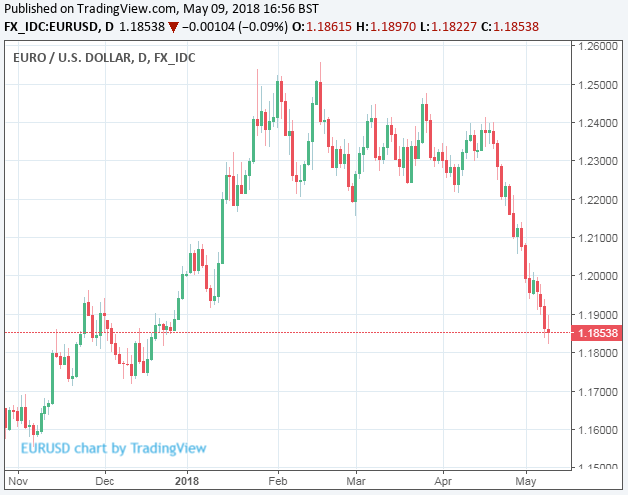Euro Faces Yet Further Losses in May and Most Analysts Might be too Generous on their EUR/USD Forecasts
- Written by: James Skinner
- UR/USD faces more losses in May but will recover soon.
- EUR/USD consensus suggests 1.25 in 2018, 1.30 in 2019.
- BofAML says long-term "fair value" is lower than many think.

© Lisa L, Adobe Stock
The Euro's losses against the US Dollar have further to run in the near-term, while the recovery that is expected to materialise over the longer-term might fall well short of consensus expectations, according to one strategist.
Europe's single currency now sits at a loss against the US Dollar for 2018 as traders have continued to cut back their bullish bets on the Euro while also abandoning earlier bearish trades against the US Dollar, creating a perfect storm that pushed the EUR/USD rate to a five-month low Tuesday.
Wednesday saw the sell-off pause after the currency pair arrived at a key technical level and the US Dollar eased broadly in a "buy the rumour and sell the fact" response to President Donald Trump's decision to withdraw the US from the so called Iran nuclear deal. However, this respite may prove short-lived if strategists at CIBC Capital Markets are correct in claiming the recent "positioning adjustment" still has further to run.
"We generally don’t place too much of an emphasis on FX futures, but the EUR is the market’s biggest long while the USD is the biggest short. Both are close to extreme levels which suggests that spot EUR/USD price action remains a decent barometer for real time positioning adjustments," says Bipan Rai, a macro strategist at CIBC Capital Markets. "EUR/USD has taken out support at the 1.1900 level and we envisage a deeper retracement to the 1.1700 area indicative of further USD short/EUR long covering."
The EUR/USD rate was quoted 0.13% higher at 1.1882 during the noon session Wednesday after having dropped 3.56% during the last month alone. It is down from a peak of 1.2554 that was set back in early February.

Above: EUR/USD rate shown at daily intervals.
Rai says the rout has a little further to go but the single currency will claw-back lost ground from the Dollar later in the year because the latter will resume its earlier decline before long.
CIBC's short, medium and long-term financial models show the US Dollar is between 9% and 12% overvalued against the Euro however, for now the market remains fixated on a widening gulf between US and Eurozone bond yields.

Above: 10 Year US Government Bond Yield.
After all, the US 10 year yield is still hugging the 3% threshold due an increasing supply of new bonds hitting the market and rising US inflation, while German yields remain remain close to a two-month low and substantially beneath those of their US counterpart, thanks largely to sub-par inflation and fears of a slowdown in Eurozone economic growth.

Above: 10 Year German Government Bond Yield.
Advertisement
Get up to 5% more foreign exchange by using a specialist provider to get closer to the real market rate and avoid the gaping spreads charged by your bank when providing currency. Learn more here.
Have EUR/USD Forecasters Jumped the Shark?
Rai and the CIBC team's prediction of further losses ahead comes closely on the heels of a research report from Bank of America Merrill Lynch, in which the bank's strategists claim a majority of analysts have been far too optimistic in their forecasts for the EUR/USD rate over the coming years.
"Despite the recent USD rally, the consensus remains bullish on the Euro beyond the short term and expects the EURUSD equilibrium to be well above current levels and between 1.40 to 1.50. We disagree," writes Athanasios Vamvakidis, an FX strategist at Bank of America, in a recent note.
The analyst consensus for the exchange rate at the end of 2018 is 1.25. On a 12 month horizon the consensus is 1.28 and for 2019, it is 1.30. Furthermore, prices of FX forwards, which are financial derivatives that enable companies and consumers to lock in exchange rates years in advance, place the EUR/USD rate respectively at 1.39 and 1.52 in five and 10 years time.

Above: EUR/USD exchange rate shown at monthly intervals.
This bullish consensus developed in June 2017 when Eurozone economic growth had picked up to a post-crisis high, continental unemployment was trending lower and the European Central Bank floated the idea of ending its quantitative easing programme (QE). Since then the ECB has taken steps to shutter its crisis-era economic stimulus program, although economic growth has slowed a touch in the New Year and Eurozone inflation has turned away from the ECB's 2% target and began to sink lower again.

Above: Graph taken from Bank of America research report.
"Looking at the EUR real effective exchange rate, it is very close to its historical average. This is also the case for the USD real effective exchange rate. This suggests the EURUSD equilibrium is unlikely to be far from the current EURUSD level. Otherwise, the USD will be much weaker than its historical average, while the EUR will by much stronger than its historical average," says Vamvakidis.

Above: Graph taken from Bank of America research report.
Vamvakidis says their are grounds for thinking the EUR/USD rate, as well as its "equilibrium", will still rise over the medium term. However, the current consenus implies that the exchange rate will return to the levels it was at before the ECB began its QE and negative interest rate policies, while overlooking the way in which the world has changed during the last four years or more.
The crucial oversight is that before the ECB first began it's QE programme, the Federal Reserve was also running its own stimulus programme and American interest rates were close to zero. Since this time, the Fed has ceased its intervention in American bond markets and the Federal Funds rate has risen so that it now stands at 1.75%, while some Eurozone interest rates are still deep in negative territory and the main refinancing rate still sits at zero. This is a game changer when it comes to currency valuation.
"The market's expectations that the EURUSD long-term equilibrium is well above current levels is wrong. Of course EURUSD can overshoot fundamentals in the short term, but this is not sustainable. Our estimate of the EURUSD equilibrium is between 1.23 to 1.24. We remain bearish EURUSD this year, forecasting a further depreciation to 1.15 this summer, but expect it to appreciate back to 1.25 by the end of 2019, which slightly above its long-term equilibrium," Vamvakidis concludes.
Advertisement
Get up to 5% more foreign exchange by using a specialist provider to get closer to the real market rate and avoid the gaping spreads charged by your bank when providing currency. Learn more here.




